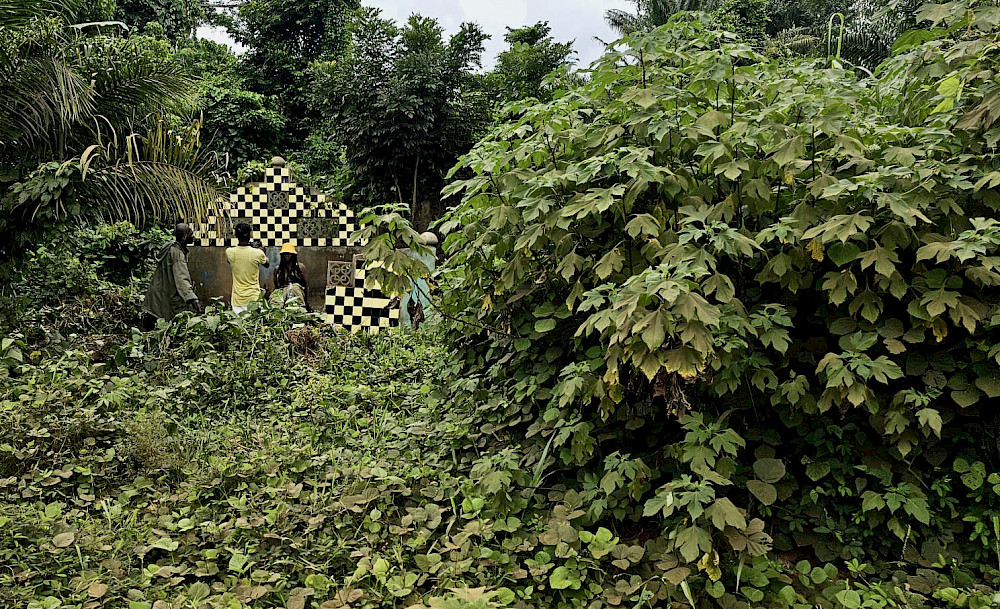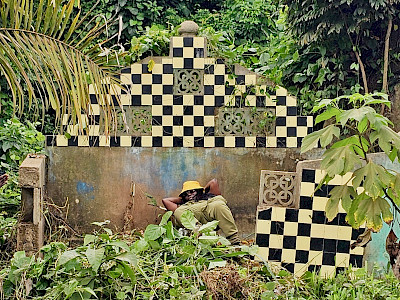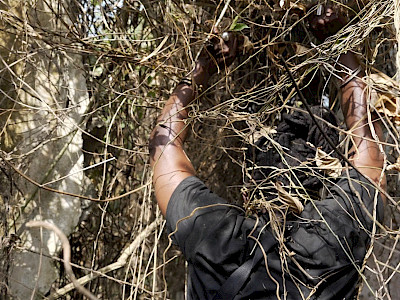09 — 13.05.2025
For her new creation, Nadia Beugré takes a solitary journey. A journey to the village of her ancestors, the village of her childhood: Yikakou. This village no longer exists: the land, considered cursed, is now covered with forest. Beugré’s journey developed into a quest for various archetypal female figures.
The figure of the grandmother who gave her the name Gbahihonon, “woman who says what she sees”. The figure of Dô-Kamissa, the ageing woman who, after being wronged by her brother, transformed herself into a buffalo to destroy his land. Acting as a female oracle, she skilfully arranged the marriage of the king with Sogolon Kandé, the hunchbacked woman.
Beugré incarnates all these different women in an incredibly powerful solo performance. With generous and explosive performativity, she shares every drop of her own existence and that of her ancestors who still live within her. Inhabited by these female voices from the past, between collective memories and intimate recollections, Beugré surrounds herself on stage with two other women: a griot, the chronicler of forgotten clans and stories, and a musician/singer. Both echo and bear witness to her story in this captivating performance presented at the opening of the festival.
Yikakou
July 2024. Nadia sets off for the land of her childhood, insearch of Yikakou, her father’s village. In search of... , because Yikakou, which literally means “come and die!”, as a challenge thrown down to anyone who dares to attack it and feared for the strength and courage of its inhabitants, no longer exists... Another Macondo (1) lost in memories, Yikakou has been swallowed up by the forest and by certain spells cast during one or two disputes. But the stories of those who went away, heading to the city or to the surrounding villages, are still whispered there; the stories of those who stayed behind, left under the trees. For in these lands, people buried their dead at the bottom of their plots, alongside the living. A red dirt road, a milky sky, butterflies and green everywhere, the nearest village is a few kilometres away... A hint given over the phone: the house and graves are behind the trunk of a large kapok tree. We return with helping hands and machetes—a few family members from the neighbouring village. After an hour or two, the first graves appear—that of the grandfather, facing the road like the other graves in the village; that of the father, facing Mecca; then the large house, one of the few solidly built houses in the village. Banana trees split the concrete with their large green shoots. We remain on the threshold...
The rope must be connected to something...
Finding the village means finding the path, the road, the other end of the rope to prevent it from slipping through our fingers. Finding the father, a complex, revered figure; finding the great-aunt, the woman who gave Nadia her second name, Gbahihonon, “woman who says what she sees”. A woman of strong character and a keeper of knowledge, Gbahihonon, as they remember, protected this small community from attacks, whether physical or mystical, and knew how to predict the fate of newborns. Through these stories of the women of the family, we also discover those often overlooked founding figures who,in the shadows of memories, built and destroyed empires and lineages, such as Dô-Kamissa. An ageing woman who had been wronged by her brother, she transformed herself into a buffalo to ravage his lands. A female oracle, she skilfully arranged the marriage of Naré Maghann Konaté, the king, to Sogolon Kandé, an ugly, hunchbacked woman who was the double of Dô-Kamissa and who was also associated with the figure of the buffalo woman. From this unusual union was born Sundiata Keita, and the epic that has spanned centuries.
A stage-territory...
The performance platform becomes a terrain of memo ries and explorations, strewn with paper tissues that mop sweaty foreheads, stained with kaolin and shea butter like so many human traces, scars of a life of turmoil... The village establishes itself there, the absent ones take their places, and the sounds of childhood games, daily rumours, forest noises, the sighs of the king and the ugly woman’s wedding night, those first desires, resonate throughout. Inhabited by these voices, between collective memories and intimate recollections, Nadia is accompanied by others—Salimata, one of the few female balafon players in Burkina Faso, and Charlotte, an Ivorian Zouglou singer who carries with her the everyday life and stories of Abidjan. By turns accomplices and witnesses, disruptive and disrupted, transformed, the three women embark on this uncertain, epic journey...
- Virginie Dupray, April 2025
- Translated by Jodie Hruby
(1) Macondo refers to the fictional town described in Gabriel García Márquez’s novel One Hundred Years of Solitude [trans.]
Presentation: Kunstenfestivaldesarts, Charleroi danse
Artistic direction and performance: Nadia Beugré | Performance and live music: Charlotte Dali, Salimata Diabate | Dramaturgy: Kader Lassina Touré | Set design: Jean-Christophe Lanquetin | Original music: Lucas Nicot | Technical direction and lighting: Paulin Ouedraogo | Production manager: Virginie Dupray
Production: Libr'Arts | Coproduction: Kunstenfestivaldesarts, Charleroi danse, Montpellier Danse, Festival d'Automne à Paris, Theater Freiburg, Centre chorégraphique national de Caen en Normandie in the context of Accueil Studio, ICI Centre Chorégraphique National de Montpellier Occitanie as part of the associate artist programme
With the support of DRAC Occitanie/French Ministry of Culture, Région Occitanie Pyrénées Méditerranée, Spielart festival | Thanks to: Ivoire Marionnettes and the Institut français de Côte d’Ivoire
Performances in Brussels with the support of the French Embassy in Belgium and the Institut français Paris as part of IF Incontournable




